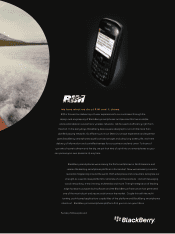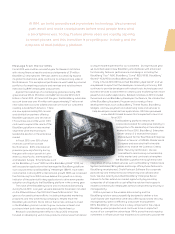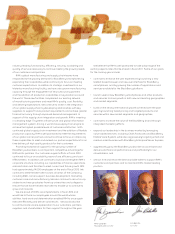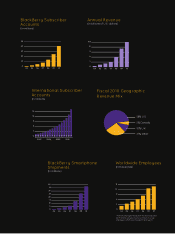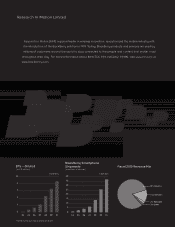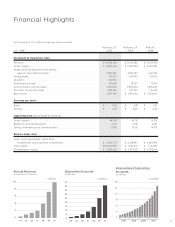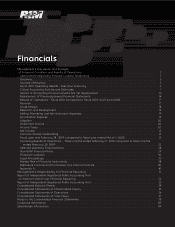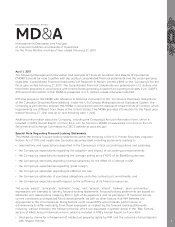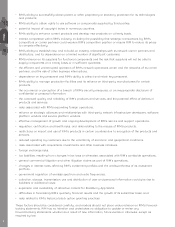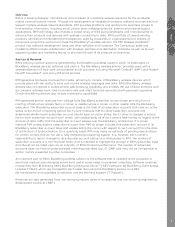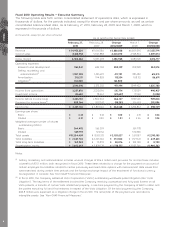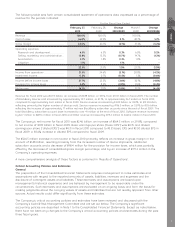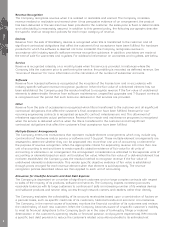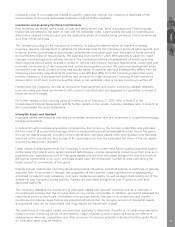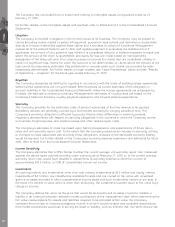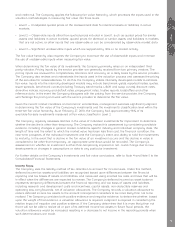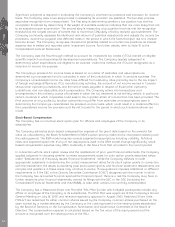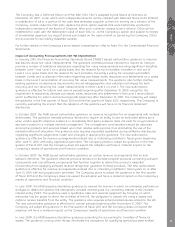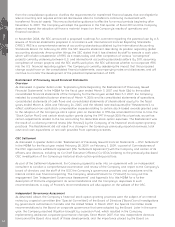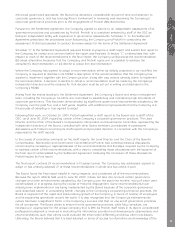Blackberry 2010 Annual Report Download - page 13
Download and view the complete annual report
Please find page 13 of the 2010 Blackberry annual report below. You can navigate through the pages in the report by either clicking on the pages listed below, or by using the keyword search tool below to find specific information within the annual report.
Overview
RIM is a leading designer, manufacturer and marketer of innovative wireless solutions for the worldwide
mobile communications market. Through the development of integrated hardware, software and services that
support multiple wireless network standards, RIM provides platforms and solutions for seamless access to
time-sensitive information, including email, phone, short messaging service, Internet and intranet-based
applications. RIM technology also enables a broad array of third party developers and manufacturers to
enhance their products and services with wireless connectivity to data. RIM’s portfolio of award-winning
products, services and embedded technologies are used by thousands of organizations and millions of
consumers around the world and include the BlackBerry»wireless solution, the RIM Wireless Handheld
TM
product line, software development tools and other software and hardware. The Company’s sales and
marketing efforts include collaboration with strategic partners and distribution channels, as well as its own
supporting sales and marketing teams, to promote the sale of its products and services.
Sources of Revenue
RIM’s primary revenue stream is generated by the BlackBerry wireless solution, which includes sales of
BlackBerry wireless devices, software and service. The BlackBerry wireless solution provides users with a
wireless extension of their work and personal email accounts, including Microsoft Outlook», IBM»Lotus Notes»,
Novell»GroupWise», and many ISP email services.
RIM generates hardware revenues from sales, primarily to carriers, of BlackBerry wireless devices, which
provide users with the ability to send and receive wireless messages and data. RIM’s BlackBerry wireless
devices also incorporate a mobile phone, web-browsing capability and enables the use of data functions such
as calendar, address book, task and memo lists and other functions associated with personal organizers.
Certain BlackBerry devices also include multimedia capabilities.
RIM generates service revenues from billings to its BlackBerry subscriber account base primarily from a
monthly infrastructure access fee to a carrier or reseller where a carrier or other reseller bills the BlackBerry
subscriber. The BlackBerry subscriber account base is the total of all subscriber accounts that have an active
status at the end of a reporting period. Each carrier instructs RIM to create subscriber accounts and
determines whether each subscriber account should have an active status. Each carrier is charged a service
fee for each subscriber account each month, with substantially all of such service fees having no regard to the
amount of data traffic that the subscriber account passes over the BlackBerry architecture. If a carrier
instructs RIM to deactivate a subscriber account, then RIM no longer includes that subscriber account in its
BlackBerry subscriber account base and ceases billing the carrier with respect to such account from the date
of notification of its deactivation. On a quarterly basis, RIM may make an estimate of pending deactivations
for certain carriers that do not use a fully-integrated provisioning system. It is, however, each carrier’s
responsibility to report changes to its subscriber account status on a timely basis to RIM. The number of
subscriber accounts is a non-financial metric and is intended to highlight the change in RIM’s subscriber base
and should not be relied upon as an indicator of RIM’s financial performance. The number of subscriber
accounts does not have any standardized meaning prescribed by U.S. GAAP and may not be comparable to
similar metrics presented by other companies.
An important part of RIM’s BlackBerry wireless solution is the software that is installed at the corporate or
small and medium size enterprise server level, and in some cases on personal computers. Software revenues
include fees from (i) licensing RIM’s BlackBerry Enterprise Server
TM
(“BES”) software; (ii) BlackBerry Client Access
Licenses (“CALs”), which are charged for each subscriber using the BlackBerry service via a BES;
(iii) maintenance and upgrades to software; and (iv) technical support (“T-Support”).
Revenues are also generated from non-warranty repairs, sales of accessories and non-recurring engineering
development contracts (“NRE”).
MD&A
5


